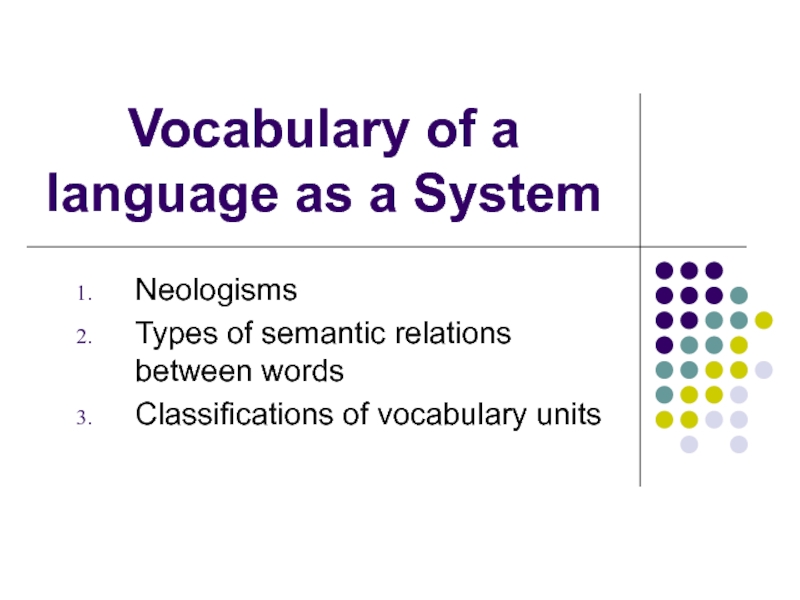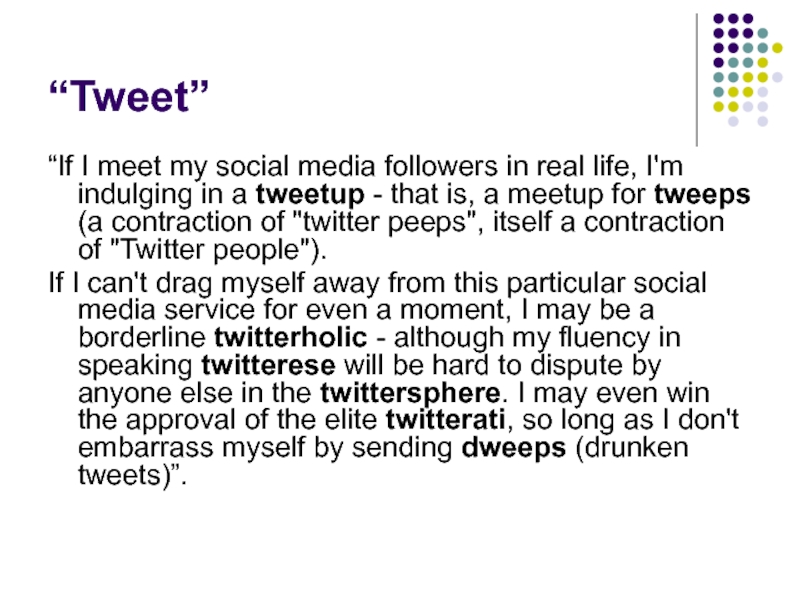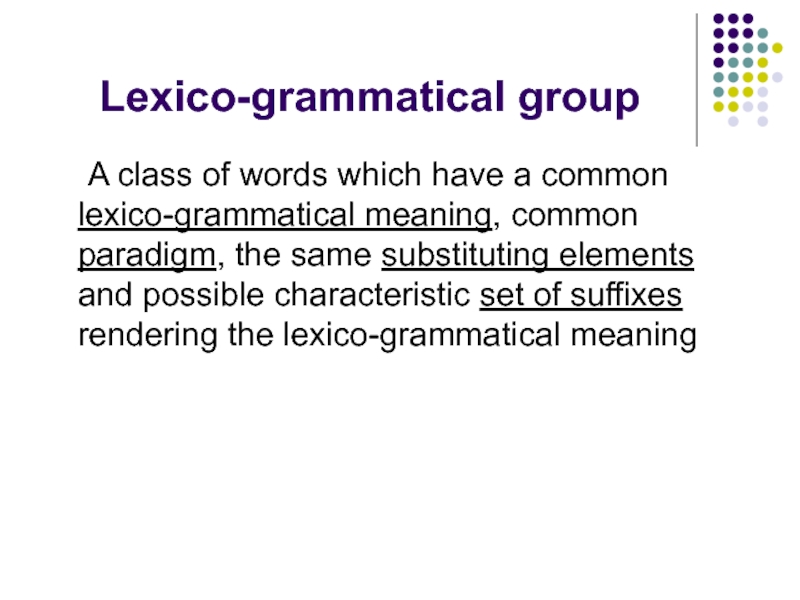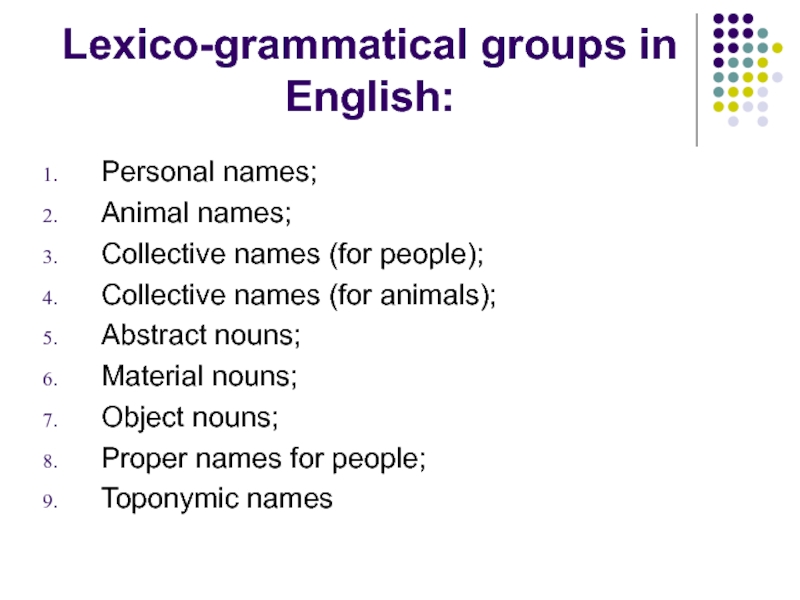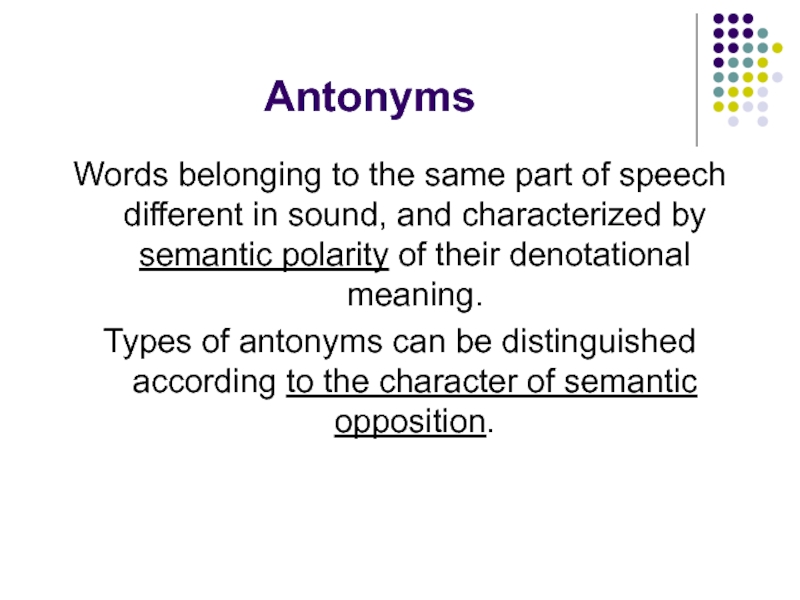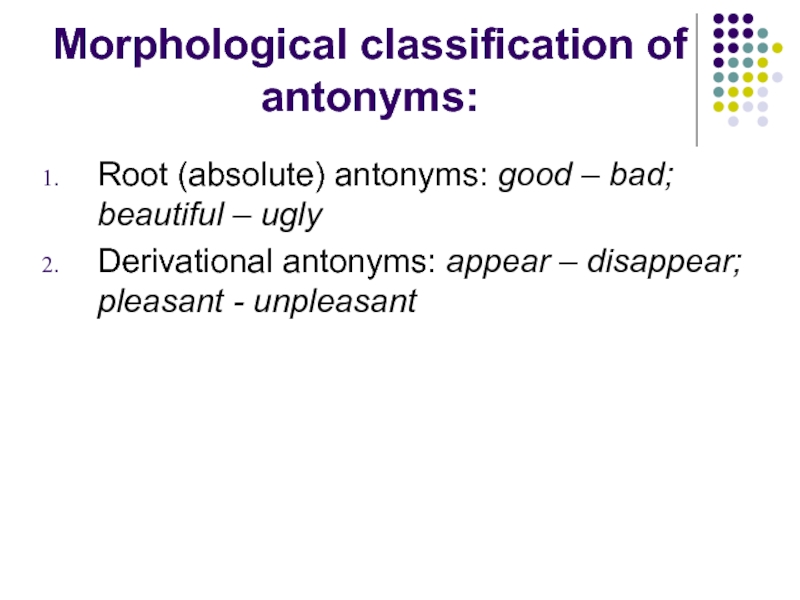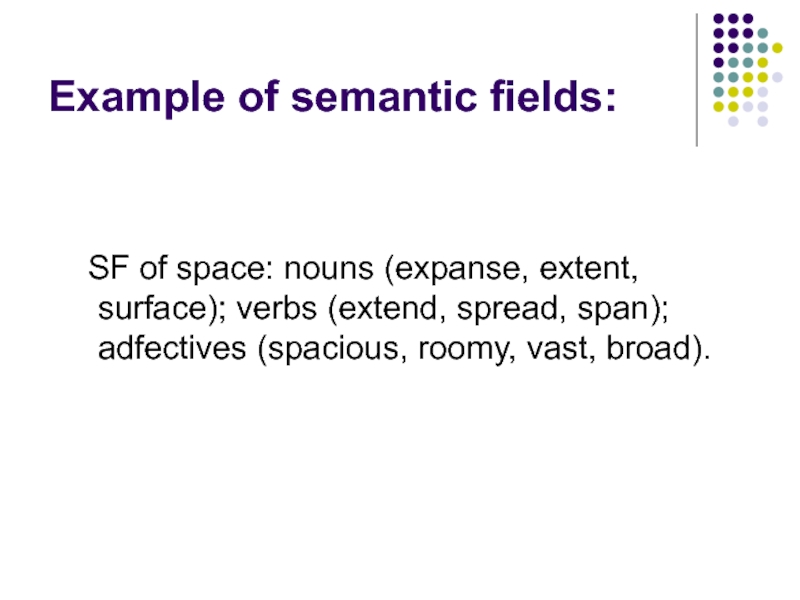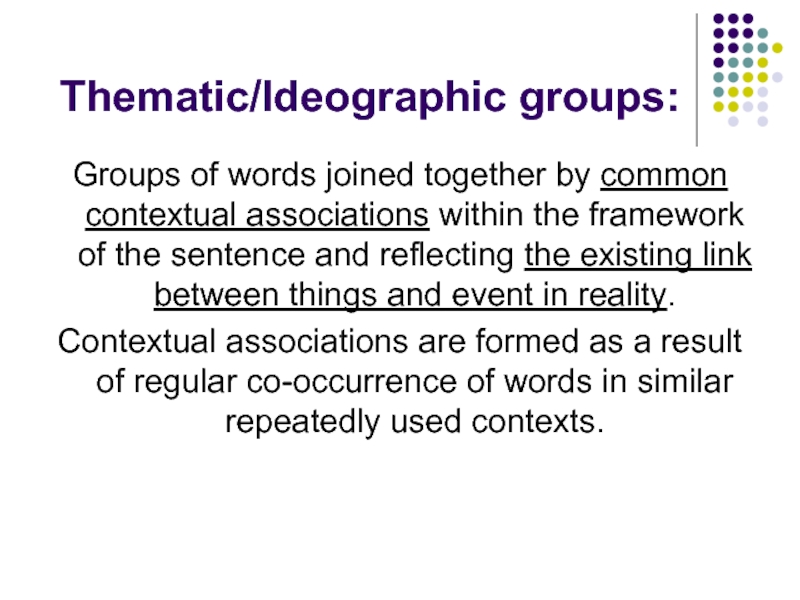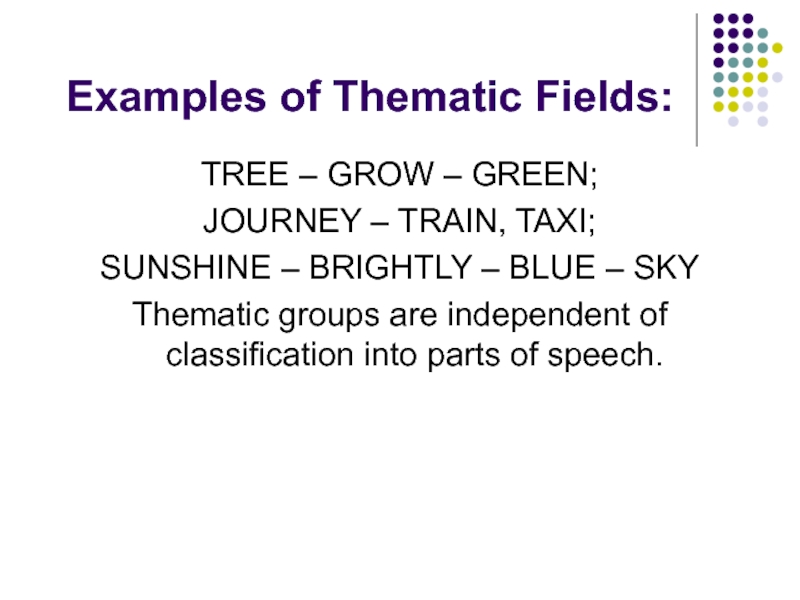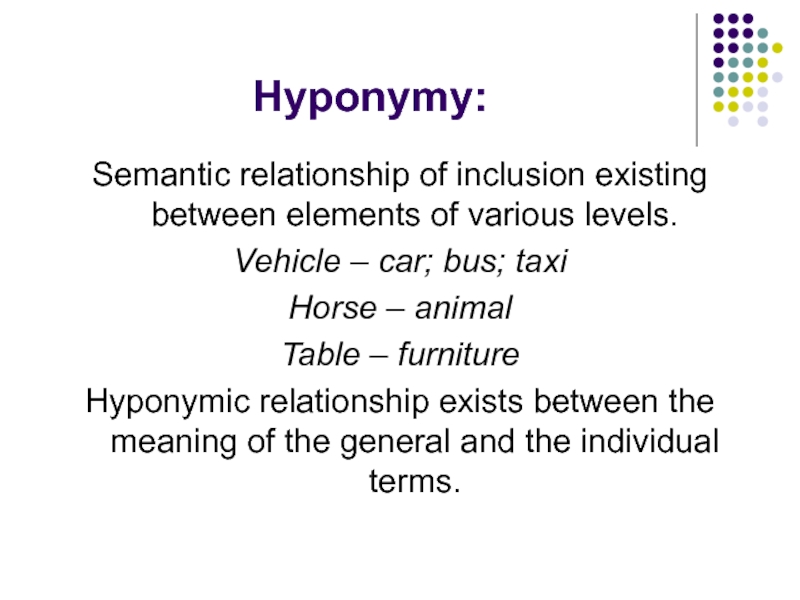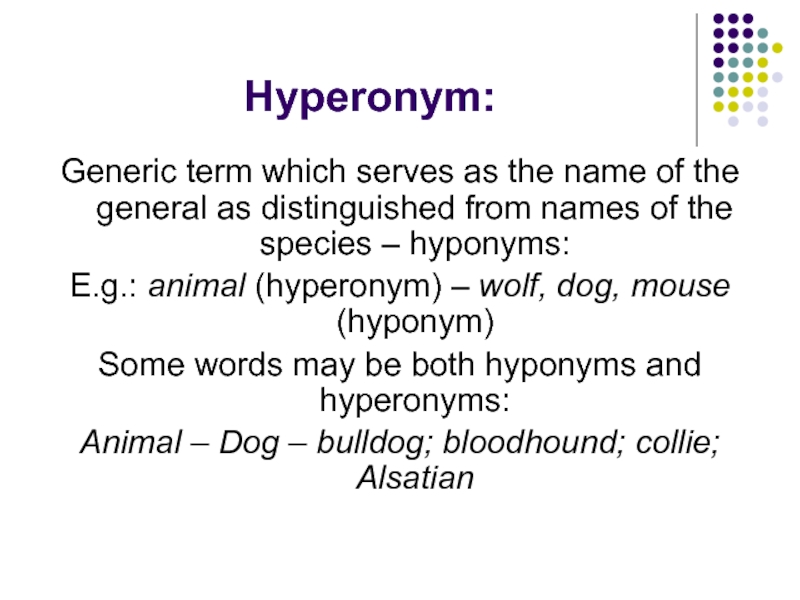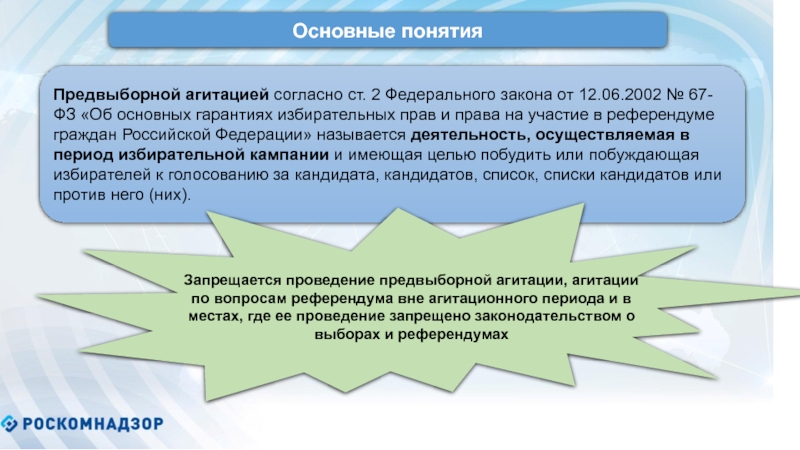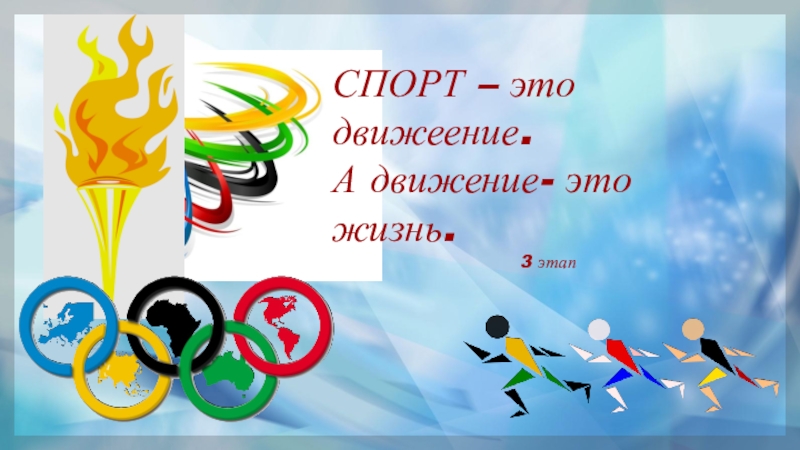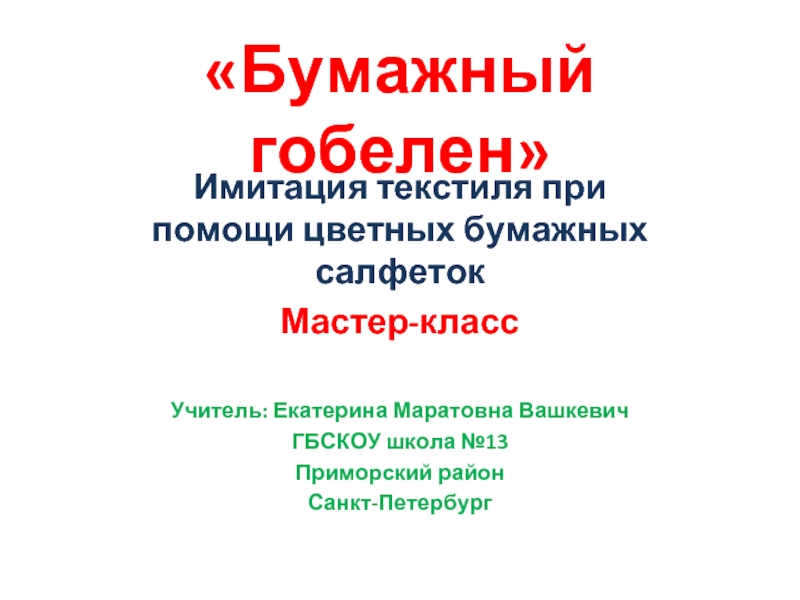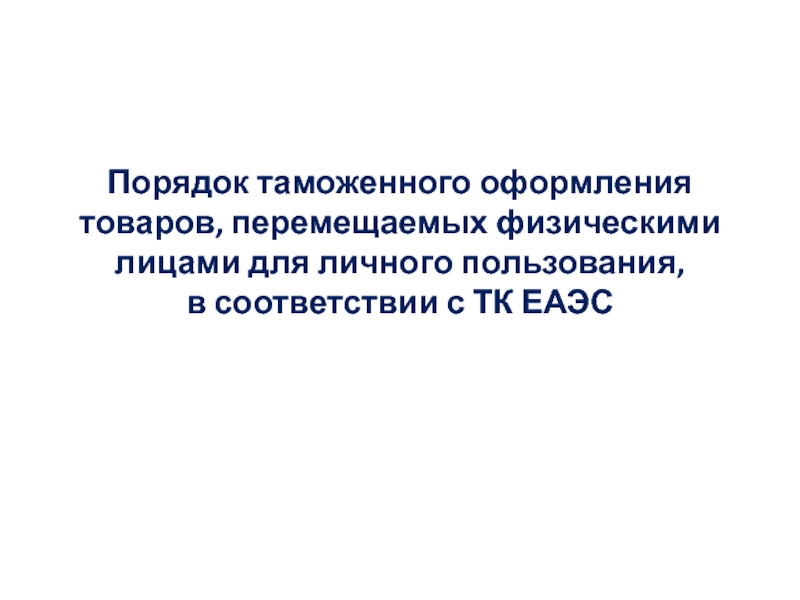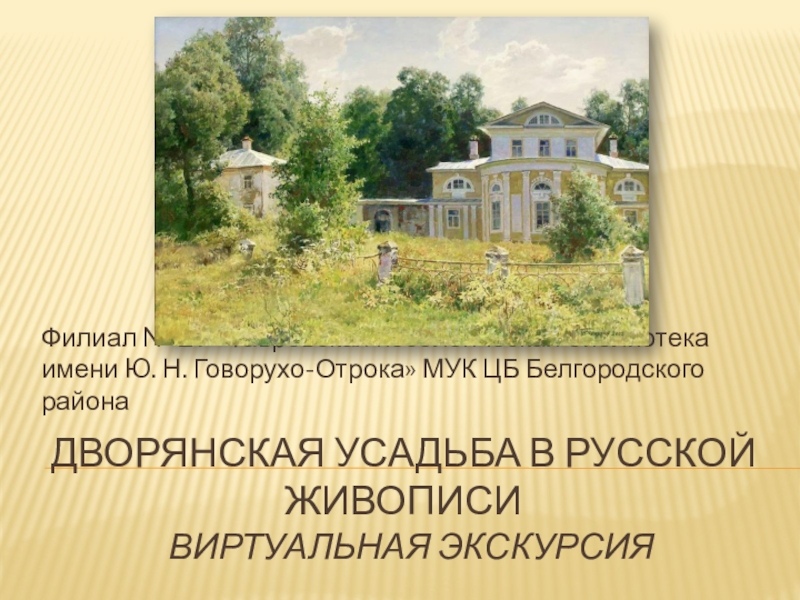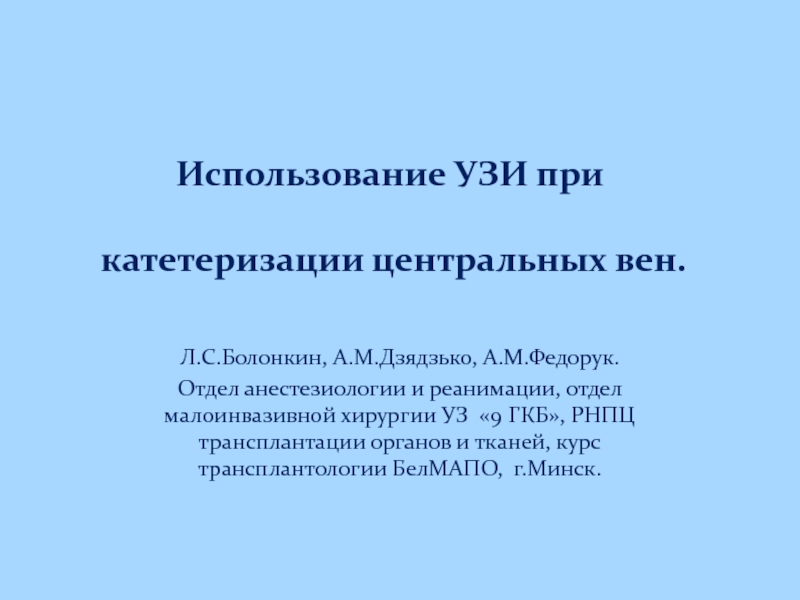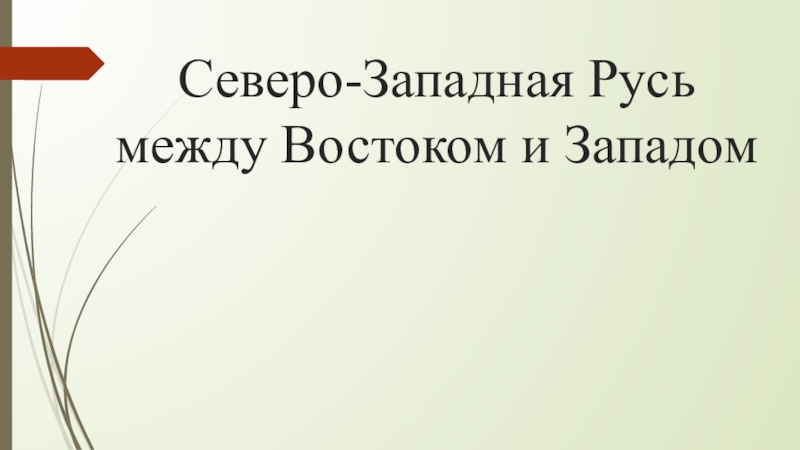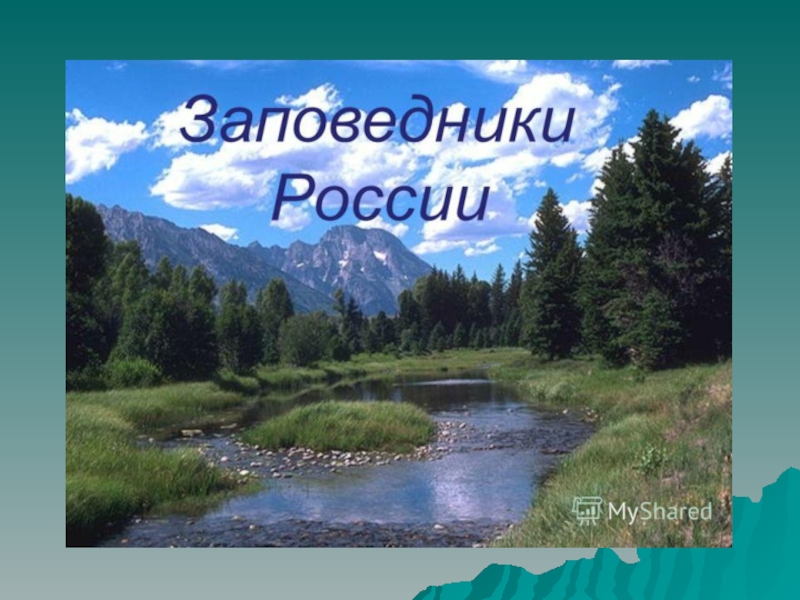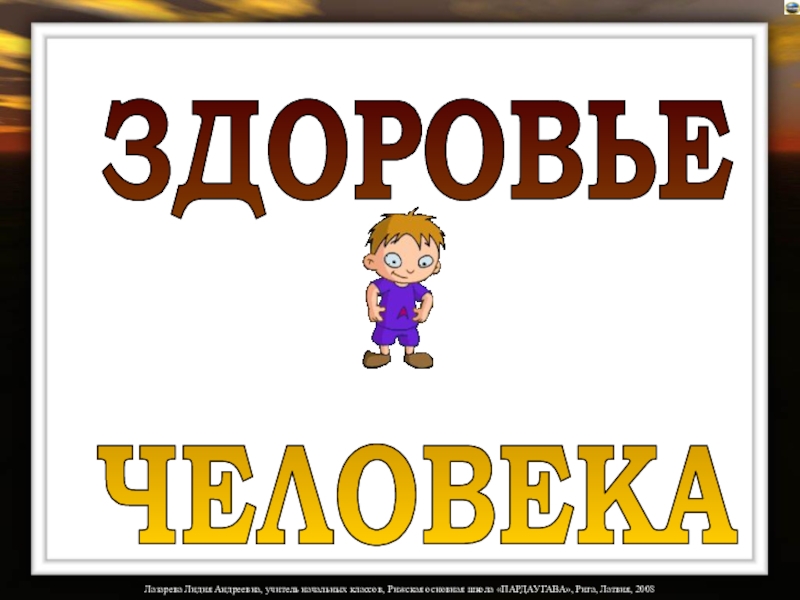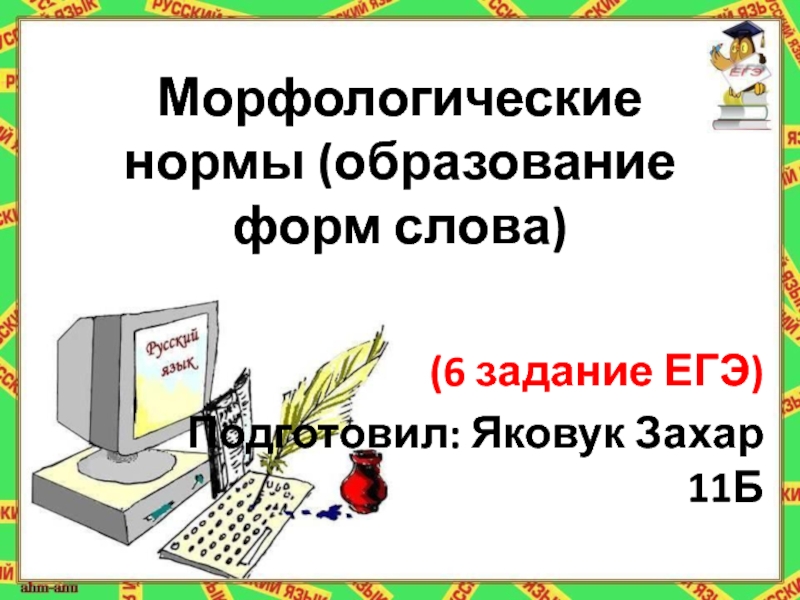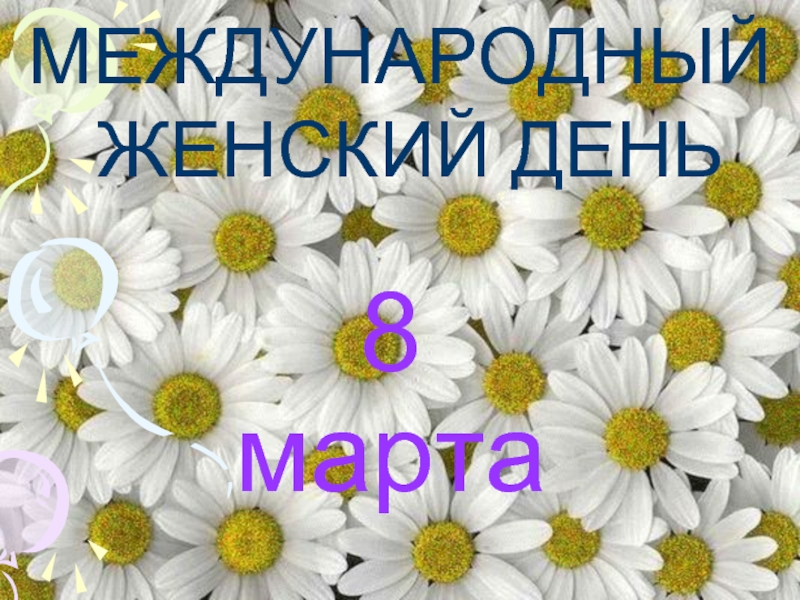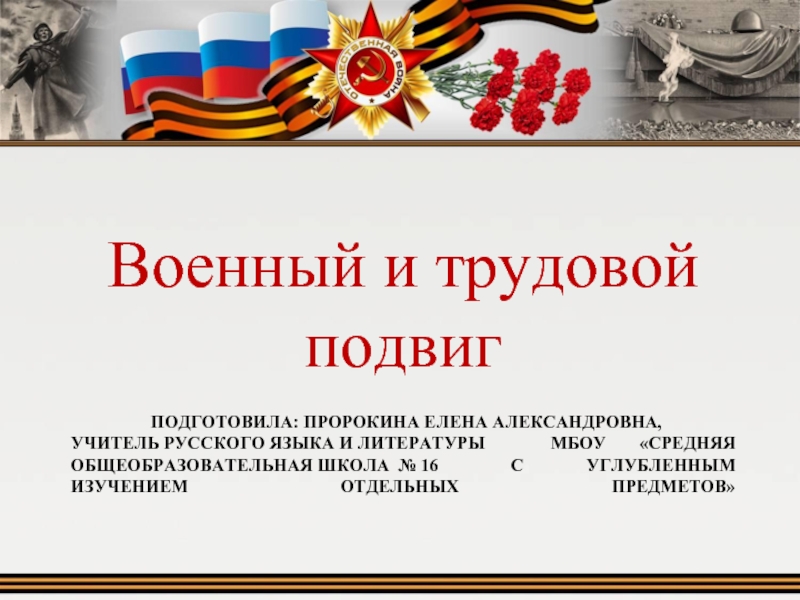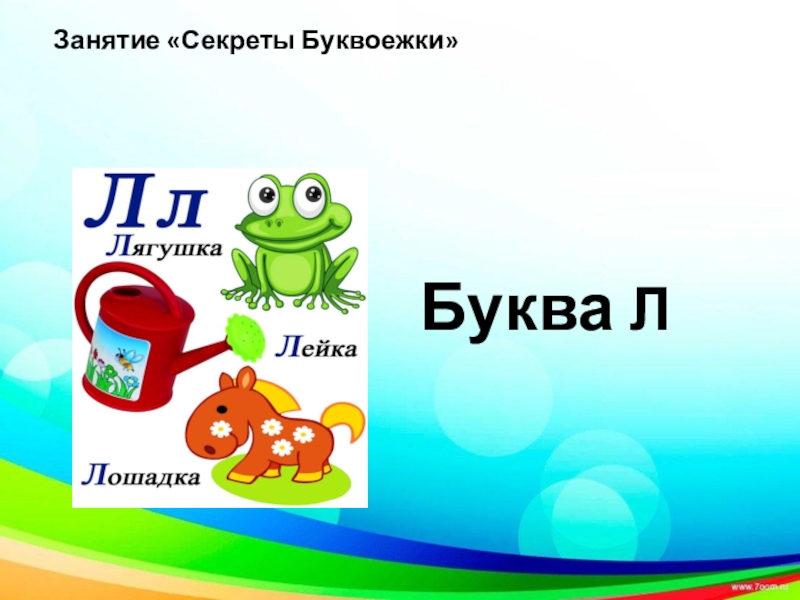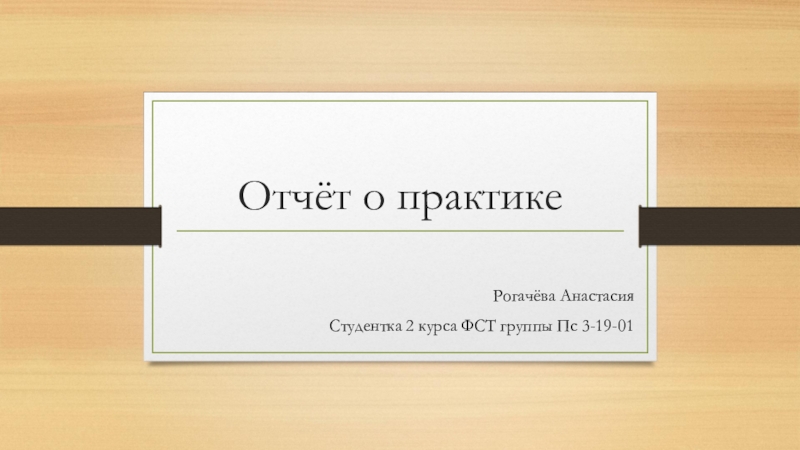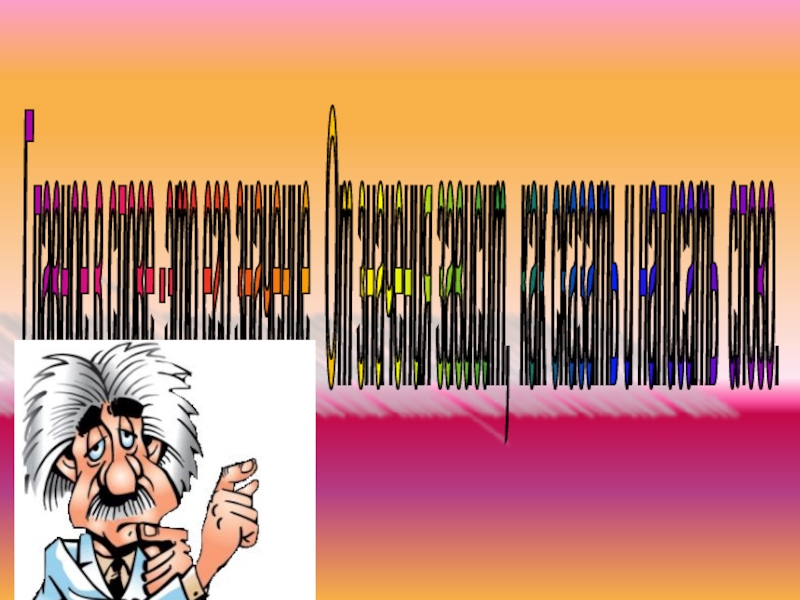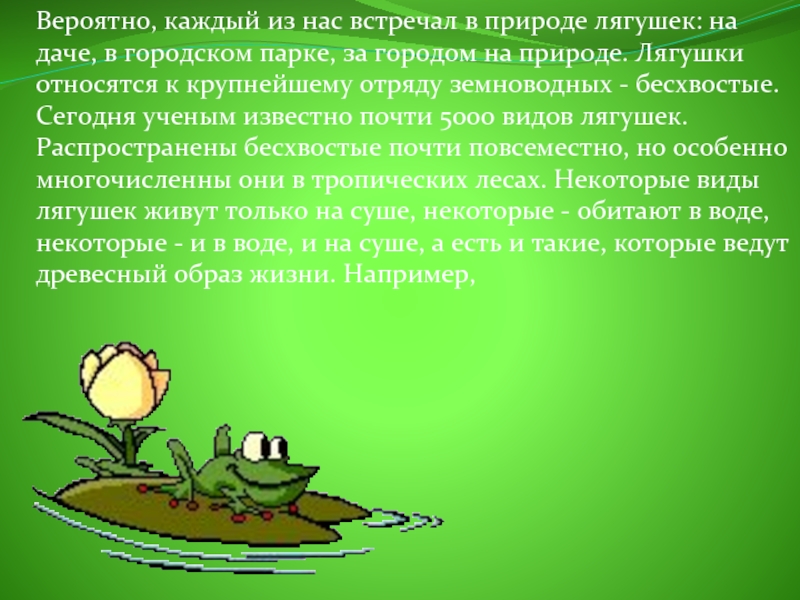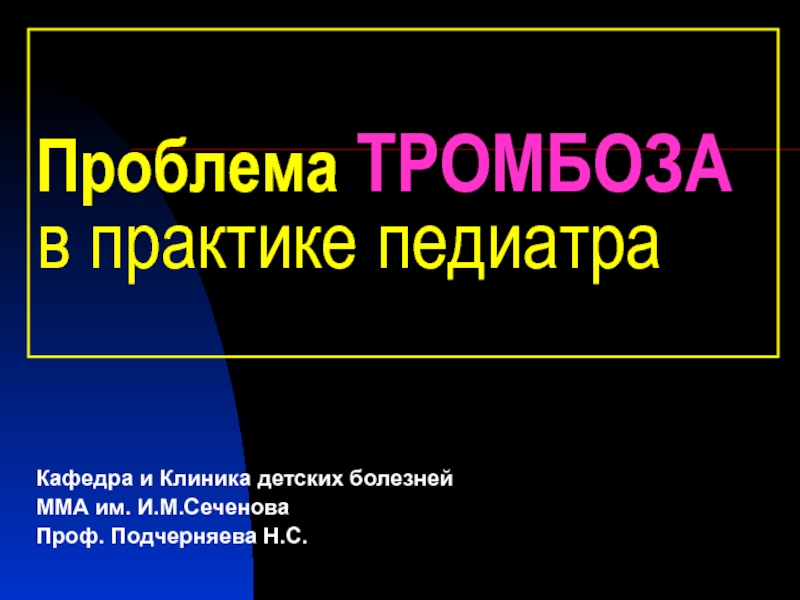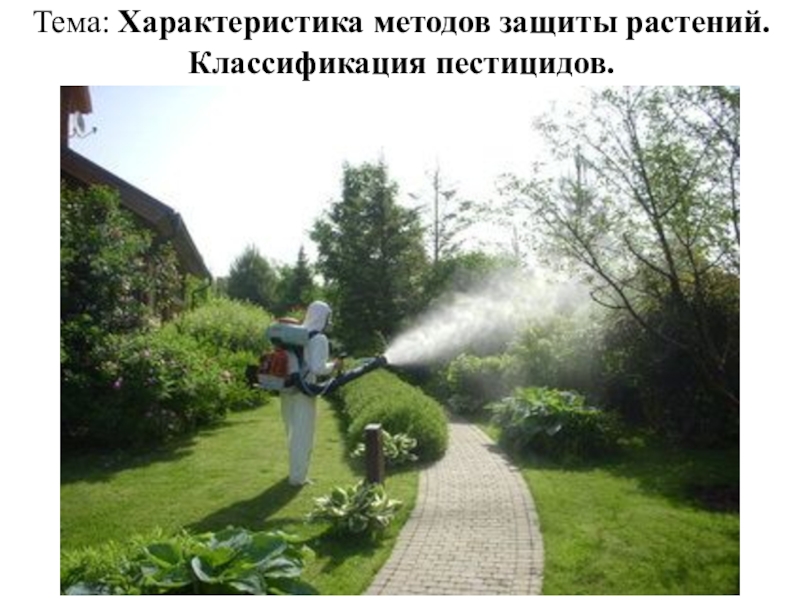Разделы презентаций
- Разное
- Английский язык
- Астрономия
- Алгебра
- Биология
- География
- Геометрия
- Детские презентации
- Информатика
- История
- Литература
- Математика
- Медицина
- Менеджмент
- Музыка
- МХК
- Немецкий язык
- ОБЖ
- Обществознание
- Окружающий мир
- Педагогика
- Русский язык
- Технология
- Физика
- Философия
- Химия
- Шаблоны, картинки для презентаций
- Экология
- Экономика
- Юриспруденция
Vocabulary of a language as a System
Содержание
- 1. Vocabulary of a language as a System
- 2. Vocabulary as an Adaptive System Vocabulary is constantly
- 3. Neologisms as an example of the adaptive
- 4. Neologisms:Produced by nearly all means of word-formation
- 5. Tech-neologisms (examples taken from www.bbc.co.uk/news)Acronyms: IMHO, OMG,
- 6. “Tweet”“If I meet my social media followers
- 7. Types of semantic relations between wordsProximity –
- 8. Lexico-grammatical group A class of words which have
- 9. Lexico-grammatical groups in English:Personal names;Animal names;Collective names
- 10. Word-families:Word grouping according to the root-morpheme:E.g.: dog, doggish, to dog, dog-days, dogcart etc.
- 11. AntonymsWords belonging to the same part of
- 12. Semantic classification of antonyms:Antonyms proper/Contraries – may
- 13. Morphological classification of antonyms:Root (absolute) antonyms: good
- 14. Semantic FieldClosely knit sector of vocabulary characterized
- 15. Example of semantic fields: SF of space: nouns
- 16. Thematic/Ideographic groups:Groups of words joined together by
- 17. Examples of Thematic Fields:TREE – GROW –
- 18. Hyponymy:Semantic relationship of inclusion existing between elements
- 19. Hyperonym:Generic term which serves as the name
- 20. Слайд 20
- 21. Скачать презентанцию
Vocabulary as an Adaptive System Vocabulary is constantly adjusting to the changing requirements and conditions of human communication and cultural and other needs. Language – constantly developing but systematic whole. Groupings of words within
Слайды и текст этой презентации
Слайд 2Vocabulary as an Adaptive System
Vocabulary is constantly adjusting to the
changing requirements and conditions of human communication and cultural and
other needs.Language – constantly developing but systematic whole.
Groupings of words within vocabulary are the result of the analysis of various relations between words.
Слайд 3Neologisms as an example of the adaptive capability of language
New
words – new notions constantly come into being, requiring new
names for them.Newly coined word or phrase or a new meaning for an existing word, or a word borrowed from another language.
Слайд 4Neologisms:
Produced by nearly all means of word-formation existing in a
given language
Sources of neologisms are extremely varied
It is often difficult
to state unambiguously when exactly a word stops being a neologismDictionaries of neologisms
Слайд 5Tech-neologisms (examples taken from www.bbc.co.uk/news)
Acronyms: IMHO, OMG, LOL, FYI, OTT
Idiolect:
lolspeek
Various coinages: to friend – to unfriend; to like –
to unlike; phablet; webinar; phoneying – pretending to be using a phone when in fact you are notСлайд 6“Tweet”
“If I meet my social media followers in real life,
I'm indulging in a tweetup - that is, a meetup
for tweeps (a contraction of "twitter peeps", itself a contraction of "Twitter people").If I can't drag myself away from this particular social media service for even a moment, I may be a borderline twitterholic - although my fluency in speaking twitterese will be hard to dispute by anyone else in the twittersphere. I may even win the approval of the elite twitterati, so long as I don't embarrass myself by sending dweeps (drunken tweets)”.
Слайд 7Types of semantic relations between words
Proximity – partial similarity of
meanings of words;
Equivalence – implies full similarity of meaning of
two or more language units. Extremely rare in case of separate words. Could be observed more regularly in case of phrases;Opposition – the contrast of semantic features.
Слайд 8Lexico-grammatical group
A class of words which have a common lexico-grammatical
meaning, common paradigm, the same substituting elements and possible characteristic
set of suffixes rendering the lexico-grammatical meaningСлайд 9Lexico-grammatical groups in English:
Personal names;
Animal names;
Collective names (for people);
Collective names
(for animals);
Abstract nouns;
Material nouns;
Object nouns;
Proper names for people;
Toponymic names
Слайд 10Word-families:
Word grouping according to the root-morpheme:
E.g.: dog, doggish, to dog,
dog-days, dogcart etc.
Слайд 11Antonyms
Words belonging to the same part of speech different in
sound, and characterized by semantic polarity of their denotational meaning.
Types
of antonyms can be distinguished according to the character of semantic opposition.Слайд 12Semantic classification of antonyms:
Antonyms proper/Contraries – may embrace several elements
characterized by different degrees of the same property. Always imply
comparison: large/little – small; young – old;Complemetaries/Contradictories – based on binary opposition; include only two members: dead – alive;
Conversives – words denoting one and the same referent as viewed from different points of view: to buy – to sell; to give – to recieve
Слайд 13Morphological classification of antonyms:
Root (absolute) antonyms: good – bad; beautiful
– ugly
Derivational antonyms: appear – disappear; pleasant - unpleasant
Слайд 14Semantic Field
Closely knit sector of vocabulary characterized by a common
concept.
Members of the semantic field are not synonymous components,
but are joined together by some common semantic component – common denominator of meaning (e.g.: concept of kinship, concept of colour, parts of human body).Слайд 15Example of semantic fields:
SF of space: nouns (expanse, extent, surface);
verbs (extend, spread, span); adfectives (spacious, roomy, vast, broad).
Слайд 16Thematic/Ideographic groups:
Groups of words joined together by common contextual associations
within the framework of the sentence and reflecting the existing
link between things and event in reality.Contextual associations are formed as a result of regular co-occurrence of words in similar repeatedly used contexts.
Слайд 17Examples of Thematic Fields:
TREE – GROW – GREEN;
JOURNEY – TRAIN,
TAXI;
SUNSHINE – BRIGHTLY – BLUE – SKY
Thematic groups are independent
of classification into parts of speech.Слайд 18Hyponymy:
Semantic relationship of inclusion existing between elements of various levels.
Vehicle
– car; bus; taxi
Horse – animal
Table – furniture
Hyponymic relationship exists
between the meaning of the general and the individual terms.Слайд 19Hyperonym:
Generic term which serves as the name of the general
as distinguished from names of the species – hyponyms:
E.g.: animal
(hyperonym) – wolf, dog, mouse (hyponym)Some words may be both hyponyms and hyperonyms:
Animal – Dog – bulldog; bloodhound; collie; Alsatian
